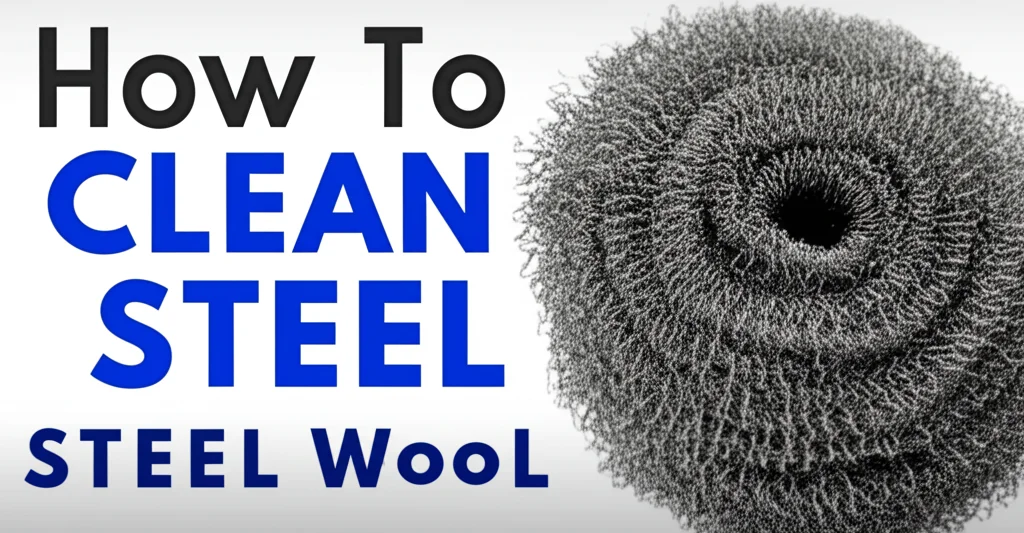· Cleaning Tips · 7 min read
How To Clean With Steel Wool

Cleaning Power Unleashed: How To Clean With Steel Wool
Ever wondered if that ball of steel wool in your cleaning supplies cabinet is good for more than just scrubbing pots? You’re in luck! Steel wool is a surprisingly versatile cleaning tool, capable of tackling tough messes on a variety of surfaces. This guide will show you how to clean with steel wool safely and effectively, unlocking its potential for a sparkling clean home. We’ll cover everything from removing rust to polishing metal, ensuring you get the best results without damaging your belongings. Let’s dive into the world of steel wool and discover its cleaning prowess.
Quick Answer: Steel wool, available in different grades, is used for cleaning by gently abrading surfaces to remove rust, grime, and buildup. Always test in an inconspicuous area first and use appropriate safety precautions like gloves and eye protection.
Takeaway:
- Steel wool is a powerful cleaning tool for various surfaces.
- Choosing the right grade of steel wool is crucial to avoid damage.
- Always test in a hidden area before cleaning the entire surface.
Understanding Steel Wool Grades
Before you start scrubbing, it’s important to understand that not all steel wool is created equal. Steel wool comes in different grades, numbered from 0000 (very fine) to #4 (coarse). The lower the number, the finer the wool. Choosing the right grade is essential to avoid scratching or damaging the surface you’re cleaning.
- 0000 Steel Wool: This is the finest grade and is ideal for polishing delicate surfaces like brass, copper, and silver. It’s also great for applying finishes like oil or wax.
- 000 Steel Wool: Slightly more abrasive than 0000, this grade is good for cleaning and polishing wood, removing light scratches from plastic, and cleaning fiberglass.
- 00 Steel Wool: This grade is a step up in abrasiveness and can be used for removing paint drips, cleaning cast iron, and preparing surfaces for refinishing.
- 0 Steel Wool: A more robust option, suitable for removing heavier rust, cleaning heavily soiled metal, and stripping old finishes.
- #1, #2, #3, & #4 Steel Wool: These are the coarsest grades and are typically used for heavy-duty industrial cleaning, removing thick rust, and stripping paint from metal. These are rarely needed for household cleaning.
Removing Rust with Steel Wool: A Step-by-Step Guide
Rust can be a stubborn problem, but steel wool is often the most effective solution. Here’s how to tackle rust using steel wool:
- Gather Your Supplies: You’ll need steel wool (grade 0 or 00 depending on the rust severity), gloves, safety glasses, a rust converter or oil (optional), and a clean cloth.
- Protect Yourself: Wear gloves and safety glasses to protect your hands and eyes from rust particles and steel wool fibers.
- Scrub the Rust: Gently scrub the rusted area with the steel wool, using a back-and-forth motion. Apply moderate pressure, but avoid excessive force.
- Remove Rust Dust: Wipe away the rust dust with a clean, damp cloth.
- Apply Rust Converter (Optional): If the rust was severe, consider applying a rust converter to neutralize any remaining rust and prevent it from returning. Alternatively, a light coat of oil can help protect the metal.
- Polish (Optional): For a polished finish, use a finer grade of steel wool (0000) to buff the surface.
Cleaning Cast Iron Cookware with Steel Wool
Cast iron cookware requires special care, and steel wool can be a valuable tool in maintaining its seasoning. However, it’s crucial to use it correctly.
- Avoid Soap: Never use soap when cleaning cast iron, as it can strip away the seasoning.
- Use Fine Steel Wool: Opt for 00 or 000 steel wool to gently remove stuck-on food particles without damaging the seasoning.
- Scrub Gently: Scrub the cast iron in a circular motion, applying gentle pressure.
- Rinse and Dry: Rinse the cast iron with hot water and dry it thoroughly with a clean cloth.
- Re-Season: After cleaning, re-season the cast iron by applying a thin coat of oil and heating it in the oven. This helps maintain the protective coating. You can find more information on cast iron care at https://www.beacleaner.com/how-to-clean-bacon-grease-from-pan/.
Polishing Metal Surfaces with Steel Wool
Steel wool isn’t just for removing grime; it’s also excellent for polishing metal surfaces like brass, copper, and stainless steel.
- Brass and Copper: Use 0000 steel wool with a metal polish to restore the shine to brass and copper items. Apply the polish to the steel wool and rub gently in the direction of the grain.
- Stainless Steel: Use 0000 steel wool to remove light scratches and water spots from stainless steel appliances. Always rub in the direction of the grain to avoid creating new scratches.
- Silver: 0000 steel wool can be used to gently polish silver, but be cautious and test in an inconspicuous area first. Follow up with a silver polish to protect the surface.
Cleaning Wood Surfaces with Steel Wool: Proceed with Caution
While steel wool can be used on wood, it requires extreme caution. It’s best suited for preparing wood for refinishing or removing minor imperfections.
- Use Fine Steel Wool: Always use 000 or 0000 steel wool to avoid scratching the wood.
- Work with the Grain: Rub the steel wool in the direction of the wood grain to minimize visible scratches.
- Test First: Always test in an inconspicuous area before cleaning the entire surface.
- Follow Up: After cleaning, apply a wood conditioner or polish to restore moisture and protect the wood. If you’re dealing with hardwood floors, consider alternative cleaning methods like those discussed at https://www.beacleaner.com/how-to-clean-hardwood-floors-with-vinegar/.
Safety Precautions When Using Steel Wool
Steel wool is a useful cleaning tool, but it’s important to prioritize safety.
- Wear Gloves: Steel wool fibers can irritate your skin, so always wear gloves.
- Wear Eye Protection: Steel wool fibers can also get into your eyes, so wear safety glasses.
- Avoid Using with Electrical Appliances: Never use steel wool to clean electrical appliances while they are plugged in.
- Proper Disposal: Dispose of used steel wool carefully to avoid injury. Wrap it in paper or place it in a sealed container before discarding it.
- Flammability: Steel wool is flammable, especially when wet. Keep it away from heat sources and avoid using it near flammable materials.
Frequently Asked Questions (FAQ)
Q: Can I use steel wool on glass? A: While possible for removing stubborn residue, it’s generally not recommended as it can easily scratch the glass. Opt for a glass scraper or specialized glass cleaner instead.
Q: What’s the difference between steel wool and scouring pads? A: Steel wool is made of fine strands of steel, providing a more abrasive cleaning action. Scouring pads are typically made of plastic or nylon and are less abrasive.
Q: Can steel wool be used on painted surfaces? A: Generally, no. Steel wool will likely remove the paint. Test in a hidden area first, but expect damage.
Q: Is steel wool safe for cleaning porcelain? A: Fine-grade (0000) steel wool can be used cautiously on porcelain, but test in an inconspicuous area first to ensure it doesn’t scratch the surface.
Q: What should I do with leftover steel wool? A: Soak the steel wool in water to prevent spontaneous combustion, then dispose of it properly wrapped in paper or in a sealed container.
Conclusion: The Versatile Power of Steel Wool
Steel wool is a surprisingly versatile cleaning tool that can tackle a wide range of messes, from rust removal to polishing metal. By understanding the different grades of steel wool and following the safety precautions outlined in this guide, you can harness its cleaning power to achieve sparkling results. Remember to always test in an inconspicuous area first and choose the appropriate grade for the surface you’re cleaning. So, next time you reach for a cleaning solution, consider the humble steel wool – it might just be the answer you’ve been looking for! Now that you know how to clean with steel wool, go forth and conquer those tough cleaning challenges!




